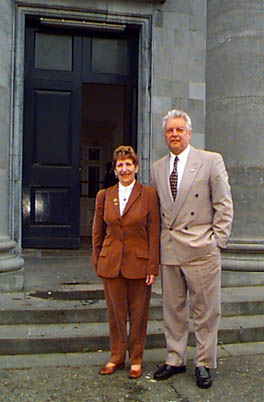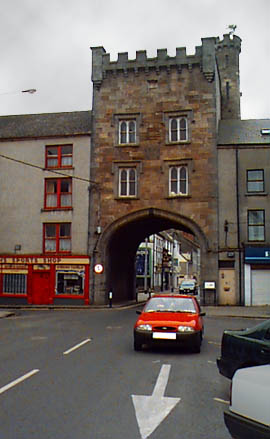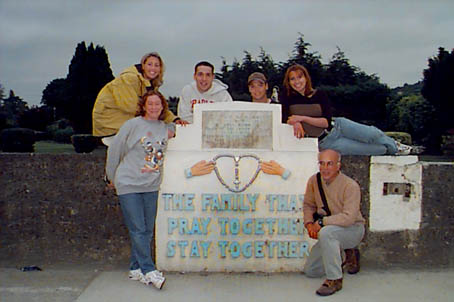
by Phillip Butera
Yesterday, Peoria's Sister City of Clonmel celebrated the opening of the Richard Mulcahy Town Park. Mulcahy was a dedicated public servant as well as the head at the Irish army. For a year now, Peoria and Clonmel have been "twinned cities." Lowell (Bud) Grieves, the mayor of Peoria, his wife, and about 45 other Peorians were honored guests for the opening celebration. Ireland's President, Mary McAleese and Councillor Vera Hewitt, the mayor of Clonmel, met with them during the day.
Glendalough to Clonmel

|
| Visiting members of Peoria's Sister Cities Commission and friends pose together in Clonmel before leaving for their next destination in Peoria's other sister city in Germany. |

|
| Before entering St. Mary's Church for Sunday Mass, Clonmel Mayor Vera Hewitt and Peoria Mayor Lowell Grieves introduced themselves to the Bradley students. |
When we reached Clonmel, we joined the group from Peoria and followed them to the historic St. Mary's Church. Mayor Bud Grieves joined Councillor Hewitt for the noon service. We photographed several sites in the city and recorded conversations with local shopkeepers and pedestrians.

|
| Mayor Hewitt has a short message of welcome to those from Peoria (180 K) |
St. Mary's Church was first completed in the 13th century. Repairs were need two centuries later and again in the 19th century. It houses several notable 16th and 17th century tombs.

|
| Shauna, 8, and her mother Shirley Keene, were at St. Mary's Church on Sunday morning for Shauna's First Communion. |
Two other historic sites are also clearly marked and displayed in the town. The Medieval West Gate was built to seclude the Irish from the Anglo-Norman town. Irishtown lies on the western side of the Gate and in those medieval times, the Irish would be required to vacate the Anglo-Norman town every evening.

|
| The Western Gate of the city was stormed and ultimately breached during the Crowellian invasions. |
The Jail Gate was once an entrance to the last jail in Clonmel during the 19th century. It was later used as the first and only reform school institution in Ireland. The River Suir winds through Clonmel, creating many beautiful spots used as city park. Waterfalls and rapids provide scenic variety, as well as fertile waters for local fishing enthusiasts.
An old part of the town is actually situated on a small island in the Suir. This QuickTime Virtual Reality panorama (256 K)was taken from the bridge leading to Suir Island.
After rejoining the group from Peoria for lunch, we drove to nearby Cahir Castle. Situated on a rocky outcrop adjacent to the River Suir, the Castle is one of the largest and best preserved castles in Ireland. Cahir, the name of the surrounding town, derives its name from the Irish word "cathair," which means stone fort.
The Rock of Cashel, also known was St. Patrick's Rock, was the next site in Clonmel's vicinity that we visited. The name Cashel derives from the Latin castellum, which suggests that it may have been used as a dynastic seat by Irish colonists returning from Britain.

|
| The Rock of Cashel rises steeply above the rich pastures below. |
St. Patrick was known for accidentally piercing King Oengus in the foot with his pastoral staff while baptizing him there. The king, assuming that this painful event was part of the ceremony, suffered it without comment. But the commoners, were said to have witnessed the event, ran away thinking that they were better off with their pagan but painless religions.
Today we had the opportunity to visit many interesting sites in this part of Ireland. Our experience with the group from Peoria made the day even better. It seems odd to travel all the way to Ireland to meet the mayor of Peoria, but it makes for a good story to tell when I get back!

|
| Becoming a family in Peoria's Sister City of Clonmel. |
Back